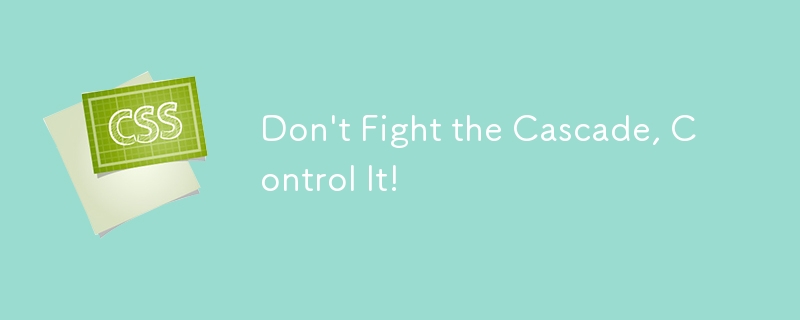Don't Fight the Cascade, Control It!
Master the CSS cascade: Say goodbye to chaos and embrace control! This article will explore how to use new CSS features to control cascades to write more concise and efficient CSS code. In the past, styles from different sources often made cascades difficult to manage and eventually produced redundant code. Even with methods like ITCSS and BEM, we still face challenges posed by cascades, such as the need to precisely control the position of the @import statement or have to resort to !important . Fortunately, some new tools have come out, allowing us to effectively control the cascade.

Drive :where pseudo selector
:where pseudo-selectror allows us to remove the particularity of the selector so that it is only higher than the user agent default style, regardless of the CSS loading order. This means that the selector's particularity is actually zero, which is very useful for general-purpose components.
For example, use :where to define a common table style:
:where(table) {
background-color: tan;
}Even if other table styles were defined before this:
table {
background-color: hotpink;
}
:where(table) {
background-color: tan;
} The table background color is still tan because :where eliminates the particularity of the selector. This makes :where perfect for CSS reset.
:where 's brother selector :is has the opposite effect:
The particularity of the
:is()pseudo-class is determined by the particularity of its most special parameters. Therefore, selectors written with:is()do not necessarily have the same speciality as equivalent selectors written without:is(). ——Selector Level 4 Specification
Continue with the previous example:
:is(table) {
--tbl-bgc: orange;
}
table {
--tbl-bgc: tan;
}
:where(table) {
--tbl-bgc: hotpink;
background-color: var(--tbl-bgc);
} The background color of the table will be tan because :is has the same particularity as table , and table is located behind it. But if we change it to:
:is(table, .c-tbl) {
--tbl-bgc: orange;
} The background color will be orange because :is has the same weight as its most special selector.c .c-tbl .
Example: Configurable table components
Let's build a table component with the following HTML:
Next, we wrap .c-tbl in :where selector and add the rounded corners:
:where(.c-tbl) {
border-collapse: separate;
border-spacing: 0;
table-layout: auto;
width: 99.9%;
}Table cells use different styles:
:where(.c-tbl thead th) {
/* ... */
}
:where(.c-tbl tbody td) {
/* ... */
} Due to rounded corners and border-collapse: separate , we need to add extra styles:
:where(.c-tbl tr td:first-of-type) {
/* ... */
}
/* ... */ Now we can create variations of the table component by injecting other styles before or after the general style (benefits from :where 's speciality elimination):
.c-tbl--purple th {
background-color: hsl(330, 50%, 40%)
}
/* ... */CSS custom properties
We will use data-component property to define the component:
The above is the detailed content of Don't Fight the Cascade, Control It!. For more information, please follow other related articles on the PHP Chinese website!

Hot AI Tools

Undresser.AI Undress
AI-powered app for creating realistic nude photos

AI Clothes Remover
Online AI tool for removing clothes from photos.

Undress AI Tool
Undress images for free

Clothoff.io
AI clothes remover

Video Face Swap
Swap faces in any video effortlessly with our completely free AI face swap tool!

Hot Article

Hot Tools

Notepad++7.3.1
Easy-to-use and free code editor

SublimeText3 Chinese version
Chinese version, very easy to use

Zend Studio 13.0.1
Powerful PHP integrated development environment

Dreamweaver CS6
Visual web development tools

SublimeText3 Mac version
God-level code editing software (SublimeText3)

Hot Topics
 Vue 3
Apr 02, 2025 pm 06:32 PM
Vue 3
Apr 02, 2025 pm 06:32 PM
It's out! Congrats to the Vue team for getting it done, I know it was a massive effort and a long time coming. All new docs, as well.
 Can you get valid CSS property values from the browser?
Apr 02, 2025 pm 06:17 PM
Can you get valid CSS property values from the browser?
Apr 02, 2025 pm 06:17 PM
I had someone write in with this very legit question. Lea just blogged about how you can get valid CSS properties themselves from the browser. That's like this.
 A bit on ci/cd
Apr 02, 2025 pm 06:21 PM
A bit on ci/cd
Apr 02, 2025 pm 06:21 PM
I'd say "website" fits better than "mobile app" but I like this framing from Max Lynch:
 Stacked Cards with Sticky Positioning and a Dash of Sass
Apr 03, 2025 am 10:30 AM
Stacked Cards with Sticky Positioning and a Dash of Sass
Apr 03, 2025 am 10:30 AM
The other day, I spotted this particularly lovely bit from Corey Ginnivan’s website where a collection of cards stack on top of one another as you scroll.
 Using Markdown and Localization in the WordPress Block Editor
Apr 02, 2025 am 04:27 AM
Using Markdown and Localization in the WordPress Block Editor
Apr 02, 2025 am 04:27 AM
If we need to show documentation to the user directly in the WordPress editor, what is the best way to do it?
 Comparing Browsers for Responsive Design
Apr 02, 2025 pm 06:25 PM
Comparing Browsers for Responsive Design
Apr 02, 2025 pm 06:25 PM
There are a number of these desktop apps where the goal is showing your site at different dimensions all at the same time. So you can, for example, be writing
 How to Use CSS Grid for Sticky Headers and Footers
Apr 02, 2025 pm 06:29 PM
How to Use CSS Grid for Sticky Headers and Footers
Apr 02, 2025 pm 06:29 PM
CSS Grid is a collection of properties designed to make layout easier than it’s ever been. Like anything, there's a bit of a learning curve, but Grid is
 Google Fonts Variable Fonts
Apr 09, 2025 am 10:42 AM
Google Fonts Variable Fonts
Apr 09, 2025 am 10:42 AM
I see Google Fonts rolled out a new design (Tweet). Compared to the last big redesign, this feels much more iterative. I can barely tell the difference






